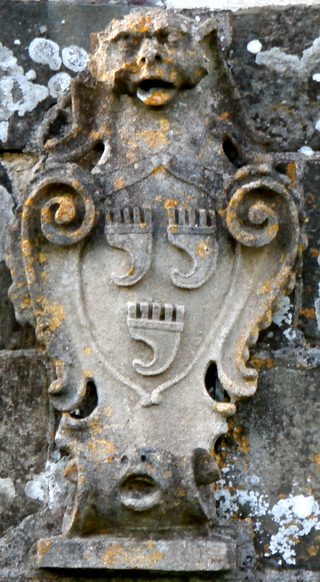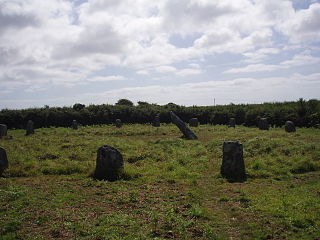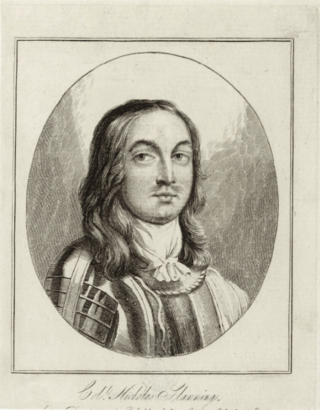
Dumnonia is the Latinised name for a Brythonic kingdom that existed in Sub-Roman Britain between the late 4th and late 8th centuries CE in the more westerly parts of present-day South West England. It was centred in the area of modern Devon, but also included modern Cornwall and part of Somerset, with its eastern boundary changing over time as the gradual westward expansion of the neighbouring Anglo-Saxon kingdom of Wessex encroached on its territory. The spelling Damnonia is sometimes encountered, but that spelling is also used for the land of the Damnonii, later part of the Kingdom of Strathclyde, in present-day southern Scotland. The form Domnonia also occurs and shares a linguistic relationship with the Breton region of Domnonée.

Sir Richard Grenville was a professional soldier from Cornwall, who served in the Thirty Years War, and 1638 to 1651 Wars of the Three Kingdoms. He was the younger brother of Sir Bevil Grenville, who died at Lansdowne in 1643, and grandson of Admiral Sir Richard, killed at Flores in 1591.

The Prayer Book Rebellion or Western Rising was a popular revolt in Cornwall and Devon in 1549. In that year, the Book of Common Prayer, presenting the theology of the English Reformation, was introduced. The change was widely unpopular, particularly in areas where firm Catholic religious loyalty still existed, such as Lancashire. Along with poor economic conditions, the enforcement of the English language literature led to an explosion of anger in Cornwall and Devon, initiating an uprising. In response, Edward Seymour, 1st Duke of Somerset sent John Russell to suppress the revolt, with the rebels being defeated and its leaders executed two months after the beginning of hostilities.

The history of Cornwall goes back to the Paleolithic, but in this period Cornwall only had sporadic visits by groups of humans. Continuous occupation started around 10,000 years ago after the end of the last ice age. When recorded history started in the first century BCE, the spoken language was Common Brittonic, and that would develop into Southwestern Brittonic and then the Cornish language. Cornwall was part of the territory of the tribe of the Dumnonii that included modern-day Devon and parts of Somerset. After a period of Roman rule, Cornwall reverted to rule by independent Romano-British leaders and continued to have a close relationship with Brittany and Wales as well as southern Ireland, which neighboured across the Celtic Sea. After the collapse of Dumnonia, the remaining territory of Cornwall came into conflict with neighbouring Wessex.

Devon is a county in south west England, bordering Cornwall to the west with Dorset and Somerset to the east. There is evidence of occupation in the county from Stone Age times onward. Its recorded history starts in the Roman period when it was a civitas. It was then a separate kingdom for a number of centuries until it was incorporated into early England. It has remained a largely agriculture based region ever since though tourism is now very important.

Sir Bevil Grenville was an English landowner and soldier who sat as a Member of Parliament for various constituencies between 1620 to 1642, although during those years there were few parliamentary sessions. When the First English Civil War broke out in August 1642, he joined the Royalists and played a leading role in their early campaigns in the West Country. He was killed in action at the Battle of Lansdowne in 1643.

The constitutional status of Cornwall has been a matter of debate and dispute. In modern times, Cornwall is an administrative county of England.

The culture of Cornwall forms part of the culture of the United Kingdom, but has distinct customs, traditions and peculiarities. Cornwall has many strong local traditions. After many years of decline, Cornish culture has undergone a strong revival, and many groups exist to promote Cornwall's culture and language today.

The Cornish people or Cornish are an ethnic group native to, or associated with Cornwall and a recognised national minority in the United Kingdom, which can trace its roots to the ancient Britons who inhabited southern and central Great Britain before the Roman conquest. Many in Cornwall today continue to assert a distinct identity separate from or in addition to English or British identities. Cornish identity has been adopted by migrants into Cornwall, as well as by emigrant and descendant communities from Cornwall, the latter sometimes referred to as the Cornish diaspora. Although not included as an tick-box option in the UK census, the numbers of those writing in a Cornish ethnic and national identity are officially recognised and recorded.

Castle an Dinas is an Iron Age hillfort at the summit of Castle Downs near St Columb Major in Cornwall, UK and is considered one of the most important hillforts in the southwest of Britain. It dates from around the 3rd to 2nd century BCE and consists of three ditch and rampart concentric rings, 850 feet (260 m) above sea level. During the early 1960s it was excavated by a team led by Dr Bernard Wailes of the University of Pennsylvania during two seasons of excavation.
Philip John Payton is a Cornish-Australian historian and Emeritus Professor of Cornish and Australian Studies at the University of Exeter and formerly Director of the Institute of Cornish Studies based at Tremough, just outside Penryn, Cornwall. An Australian citizen, he is Professor of History at Flinders University in Adelaide, South Australia.
William Scawen (1600–1689) was one of the pioneers in the revival of the Cornish language. He was a politician who sat in the House of Commons in 1640 and fought for the Royalist cause in the English Civil War.
The Gear Rout was a Cornish insurrection of 1648 following the end of the English Civil War. It involved some 500 Cornish rebels who fought on the Royalist side against the Parliamentarian forces of Sir Hardress Waller.

Sir Nicholas Slanning, 1 September 1606 to August 1643, was a soldier and landowner from Devon who sat in the House of Commons from 1640 to 1642. He served in the Royalist army during the First English Civil War and was mortally wounded at Bristol on 26 July 1643.
This timeline summarizes significant events in the History of Cornwall

Cornwall played a significant role in the English Civil War, being a Royalist enclave in the generally Parliamentarian south-west.

Donyarth or Dungarth was the last recorded king of Cornwall. He was probably an under-king, paying tribute to the West Saxons.

The New Cornish Tertia were four Royalist regiments of infantry raised in Cornwall and Devon by Sir Richard Grenville, 1st Baronet in 1644, during the English Civil War. As the maps aside show, Cornwall and Wales were staunch Royalist strongholds whilst South East England was held by Parliament, and the remainder of England was in dispute.
The Battle of Hehil was a battle won by a force of Britons, probably against the Anglo-Saxons of Wessex around the year 720. The location is unknown, except that it was apud Cornuenses.
The Cornish dialect is a dialect of English spoken in Cornwall by Cornish people. Dialectal English spoken in Cornwall is to some extent influenced by Cornish grammar, and often includes words derived from the Cornish language. The Cornish language is a Celtic language of the Brythonic branch, as are the Welsh and Breton languages. In addition to the distinctive words and grammar, there are a variety of accents found within Cornwall from the north coast to that of the south coast and from east to west Cornwall. Typically, the accent is more divergent from Standard British English the further west through Cornwall one travels. The speech of the various parishes being to some extent different from the others was described by John T. Tregellas and Thomas Quiller Couch towards the end of the 19th century. Tregellas wrote of the differences as he understood them and Couch suggested the parliamentary constituency boundary between the East and West constituencies, from Crantock to Veryan, as roughly the border between eastern and western dialects. To this day, the towns of Bodmin and Lostwithiel as well as Bodmin Moor are considered the boundary.











